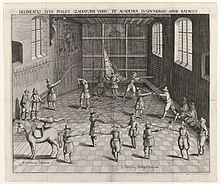Fencing, also called Olympic fencing, is a sport in which two competitors fight using 'rapier-style' swords, winning points by making contact with their opponent. Based on the traditional skills of swordsmanship, the modern sport arose at the end of the 19th century, with the Italian school having modified the historical European martial art of classical fencing, and the French school having later refined the Italian system. There are three forms of modern fencing, each using a different style of weapon and different rules, and as such the sport is divided into three competitive scenes: foil,épée, and sabre. Most competitive fencers choose to specialise in only one weapon.
Competitive fencing is one of five activities which have been featured in every one of the modern Olympic Games, the other four being athletics, cycling, swimming, and gymnastics.
Governing body[edit]
Further information: Fédération Internationale d'Escrime
Fencing is governed by Fédération Internationale d'Escrime (FIE). Today, its head office is in Lausanne, Switzerland. The FIE is composed of 145 national federations, each of which is recognised by its country's Olympic Committee as the sole representative of Olympic-style fencing in that country
Rules[edit]
Main article: Fencing practice and techniques
The FIE maintains the current rules[2] used for FIE sanctioned international events, including world cups, world championships and the Olympic Games. The FIE handles proposals to change the rules the first year after an Olympic year in the annual congress. The US Fencing Association has slightly different rules, but usually adhere to FIE standards.
History[edit]
Further information: History of fencing
Fencing traces its roots to the development of swordsmanship for duels and self defense. The ancestor of modern fencing originated in Spain, where several books on fencing were written. Treatise on Arms was written by Diego de Valera between 1458 and 1471 and is one of the oldest surviving manuals on western fencing[3] shortly before dueling came under official ban by the Catholic Monarchs. In conquest, the Spanish forces carried fencing around the world, particularly southern Italy, one of the major areas of strife between both nations.[4][5] Fencing was mentioned in the play The Merry Wives of Windsorwritten sometime prior to 1602.[6][7]

No comments:
Post a Comment